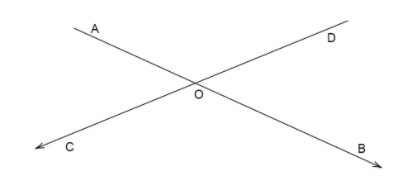
Name the four pairs of supplementary angles shown in the figure.


Answer
488.1k+ views
Hint:From the knowledge of supplementary angles that they are the angles which lie on a straight line and sum up to \[{180^ \circ }\], we name the pairs( set of two angles ) which are supplementary in nature.
Complete step-by-step answer:
We know the two lines \[AB,CD\] intersect at point \[O\].
A pair of supplementary angles will be formed if on straight line is cut by another straight line at a point.
So the supplementary angles will be formed at the point of intersection of two lines \[AB,CD\].
We take the line \[AB\] which is cut by the line \[CD\].
This divides the area into four parts and the angles formed around the point of intersection are four angles in total.
Since we know angles on a straight line sum up to be \[{180^ \circ }\]
\[\angle AOB + \angle BOD = {180^ \circ }\] and \[\angle AOC + \angle BOC = {180^ \circ }\]
Therefore set of angles seen from above on a straight line \[AB\] are \[\angle AOB,\angle BOD\]
And the set of angles seen from below on a straight line \[AB\] are \[\angle AOC,\angle BOC\]
Similarly if we take the line \[CD\] which is cut by the line \[AB\].
This divides the area into four parts and the angles formed around the point of intersection are four angles in total.
Since we know angles on a straight line sum up to be \[{180^ \circ }\]
\[\angle COA + \angle DOA = {180^ \circ }\] and \[\angle COB + \angle DOB = {180^ \circ }\]
Therefore set of angles seen from above on a straight line \[CD\] are \[\angle COA,\angle DOA\]
And the set of angles seen from below on a straight line \[CD\] are \[\angle COB,\angle DOB\]
Therefore, four pair of supplementary angles in the given figure are
* \[\angle AOB,\angle BOD\]
*\[\angle AOC,\angle BOC\]
* \[\angle COA,\angle DOA\]
*\[\angle COB,\angle DOB\]
Note:Students are likely to make the mistake of collecting all the possible pairs formed in this diagram which is wrong because there are also vertically opposite angles in the diagram which are not supplementary to each other.
Complete step-by-step answer:
We know the two lines \[AB,CD\] intersect at point \[O\].
A pair of supplementary angles will be formed if on straight line is cut by another straight line at a point.
So the supplementary angles will be formed at the point of intersection of two lines \[AB,CD\].
We take the line \[AB\] which is cut by the line \[CD\].
This divides the area into four parts and the angles formed around the point of intersection are four angles in total.
Since we know angles on a straight line sum up to be \[{180^ \circ }\]
\[\angle AOB + \angle BOD = {180^ \circ }\] and \[\angle AOC + \angle BOC = {180^ \circ }\]
Therefore set of angles seen from above on a straight line \[AB\] are \[\angle AOB,\angle BOD\]
And the set of angles seen from below on a straight line \[AB\] are \[\angle AOC,\angle BOC\]
Similarly if we take the line \[CD\] which is cut by the line \[AB\].
This divides the area into four parts and the angles formed around the point of intersection are four angles in total.
Since we know angles on a straight line sum up to be \[{180^ \circ }\]
\[\angle COA + \angle DOA = {180^ \circ }\] and \[\angle COB + \angle DOB = {180^ \circ }\]
Therefore set of angles seen from above on a straight line \[CD\] are \[\angle COA,\angle DOA\]
And the set of angles seen from below on a straight line \[CD\] are \[\angle COB,\angle DOB\]
Therefore, four pair of supplementary angles in the given figure are
* \[\angle AOB,\angle BOD\]
*\[\angle AOC,\angle BOC\]
* \[\angle COA,\angle DOA\]
*\[\angle COB,\angle DOB\]
Note:Students are likely to make the mistake of collecting all the possible pairs formed in this diagram which is wrong because there are also vertically opposite angles in the diagram which are not supplementary to each other.
Recently Updated Pages
Master Class 11 Accountancy: Engaging Questions & Answers for Success

Express the following as a fraction and simplify a class 7 maths CBSE

The length and width of a rectangle are in ratio of class 7 maths CBSE

The ratio of the income to the expenditure of a family class 7 maths CBSE

How do you write 025 million in scientific notatio class 7 maths CBSE

How do you convert 295 meters per second to kilometers class 7 maths CBSE

Trending doubts
When people say No pun intended what does that mea class 8 english CBSE

In Indian rupees 1 trillion is equal to how many c class 8 maths CBSE

How many ounces are in 500 mL class 8 maths CBSE

Which king started the organization of the Kumbh fair class 8 social science CBSE

Advantages and disadvantages of science

What is BLO What is the full form of BLO class 8 social science CBSE




